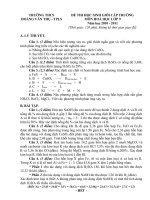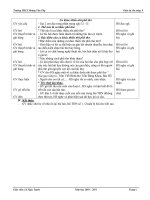trường thcs hoàng xuân hãn
Bạn đang xem bản rút gọn của tài liệu. Xem và tải ngay bản đầy đủ của tài liệu tại đây (125.25 KB, 11 trang )
<span class='text_page_counter'>(1)</span><div class='page_container' data-page=1>
E
E
l
l
e
e
m
m
e
e
n
n
t
t
a
a
r
r
y
y
M
M
a
a
t
t
h
h
e
e
m
m
a
a
t
t
i
i
c
c
s
s
I
I
n
n
t
t
e
e
r
r
n
n
a
a
t
t
i
i
o
o
n
n
a
a
l
l
C
C
o
o
n
n
t
t
e
e
s
s
t
t
<b>TEAM CONTEST </b>
Time:60 minutes
English Version
<b>For Juries Use Only </b>
No. <b>1 </b> <b>2 </b> <b>3 </b> <b>4 </b> <b>5 </b> <b>6 </b> <b>7 </b> <b>8 </b> <b>9 </b> <b>10 </b> <b>Total </b> <b>Sign by Jury </b>
Score
Score
Instructions:
Do not turn to the first page until you are told to do so.
Remember to write down your team name in the space indicated on every page.
There are 10 problems in the Team Contest, arranged in increasing order of
difficulty. Each question is printed on a separate sheet of paper. Each problem is
worth 40 points. For Problems 1, 3, 5, 7 and 9, only answers are required. Partial
credits will not be given. For Problems 2, 4, 6, 8 and 10, full solutions are
required. Partial credits may be given.
The four team members are allowed 10 minutes to discuss and distribute the first
8 problems among themselves. Each student must attempt at least one problem.
Each will then have 35 minutes to write the solutions of their allotted problem
independently with no further discussion or exchange of problems. The four
team members are allowed 25 minutes to solve the last 2 problems together.
No calculator or calculating device or electronic devices are allowed.
</div>
<span class='text_page_counter'>(2)</span><div class='page_container' data-page=2>
<b>TEAM CONTEST </b>
17
thAugust, 2016, Chiang Mai, Thailand
Team:
Score:
E
El
l
e
e
me
m
en
nt
ta
ar
r
y
y
M
Ma
at
th
he
em
ma
a
ti
t
i
c
c
s
s
I
In
n
te
t
er
r
na
n
at
ti
io
on
na
al
l
C
C
on
o
nt
te
es
st
t
<b>1.</b> Choose nine different ones of 1, 2, 3, 4, 5, 6, 7, 8, 9 and 10. Use each of them
exactly once to form three equations, using each of addition, subtraction,
multiplication and division at most once. What is the smallest number that we
can leave out?
</div>
<span class='text_page_counter'>(3)</span><div class='page_container' data-page=3>
<b>TEAM CONTEST </b>
17
thAugust, 2016, Chiang Mai, Thailand
Team:
Score:
E
El
l
e
e
me
m
en
nt
ta
ar
r
y
y
M
Ma
at
th
he
em
ma
a
ti
t
i
c
c
s
s
I
In
n
te
t
er
r
na
n
at
ti
io
on
na
al
l
C
C
on
o
nt
te
es
st
t
<b>2.</b> The squares of a 3 by 3 table are labelled 1, 2, …, 9 as shown. In how many ways
can we shade five of the squares so that no row or column is completely shaded?
1 2 3
4 5 6
7 8 9
</div>
<span class='text_page_counter'>(4)</span><div class='page_container' data-page=4>
<b>TEAM CONTEST </b>
17
thAugust, 2016, Chiang Mai, Thailand
Team:
Score:
E
El
l
e
e
me
m
en
nt
ta
ar
r
y
y
M
Ma
at
th
he
em
ma
a
ti
t
i
c
c
s
s
I
In
n
te
t
er
r
na
n
at
ti
io
on
na
al
l
C
C
on
o
nt
te
es
st
t
<b>3.</b> The diagram shows an 8 by 8 board. An ant visits each of the 64 squares once
and only once. It crawls from one to another of two squares sharing at least one
corner. The order in which the squares are visited is marked with numbers,
starting from 1 and ending at 64. Some of the marked numbers have been erased.
Restore these erased numbers.
5 26 25
10 29 23
2 31 37
1 12 19 21 38 34
13 17 49 33
59 16 50 47 40
64 46 42
55 53 52 45 43
Answer:
5 26 25
10 29 23
2 31 37
1 12 19 21 38 34
13 17 49 33
59 16 50 47 40
64 46 42
</div>
<span class='text_page_counter'>(5)</span><div class='page_container' data-page=5>
<b>TEAM CONTEST </b>
17
thAugust, 2016, Chiang Mai, Thailand
Team:
Score:
E
El
l
e
e
me
m
en
nt
ta
ar
r
y
y
M
Ma
at
th
he
em
ma
a
ti
t
i
c
c
s
s
I
In
n
te
t
er
r
na
n
at
ti
io
on
na
al
l
C
C
on
o
nt
te
es
st
t
<b>4.</b> <i>In triangle ABC, AB = 7 cm and AC = 9 cm. D is a point on AB such that </i>
<i>BD = 3 cm. E is a point on AC such that the area of the quadrilateral BCED is </i> 5
7
<i>of the area of triangle ABC</i>. Find the length, in cm, of <i>CE</i>.
Answer:
cm
<i>A </i>
<i>E </i>
<i>D </i>
</div>
<span class='text_page_counter'>(6)</span><div class='page_container' data-page=6>
<b>TEAM CONTEST </b>
17
thAugust, 2016, Chiang Mai, Thailand
Team:
Score:
E
El
l
e
e
me
m
en
nt
ta
ar
r
y
y
M
Ma
at
th
he
em
ma
a
ti
t
i
c
c
s
s
I
In
n
te
t
er
r
na
n
at
ti
io
on
na
al
l
C
C
on
o
nt
te
es
st
t
<b>5.</b> How many positive integers less than 100 are there such that the product of all
positive divisors of such a number is equal to the square of the number?
</div>
<span class='text_page_counter'>(7)</span><div class='page_container' data-page=7>
<b>TEAM CONTEST </b>
17
thAugust, 2016, Chiang Mai, Thailand
Team:
Score:
E
El
l
e
e
me
m
en
nt
ta
ar
r
y
y
M
Ma
at
th
he
em
ma
a
ti
t
i
c
c
s
s
I
In
n
te
t
er
r
na
n
at
ti
io
on
na
al
l
C
C
on
o
nt
te
es
st
t
<b>6.</b> A hat is put on the head of each of 33 children. Each hat is red, white or blue.
Each can see the hats of all other children except his or her own. Willem sees
three times as many red hats as blue hats. Maxima sees twice as many white hats
as blue hats. What is the colour of Maxima’s hat?
</div>
<span class='text_page_counter'>(8)</span><div class='page_container' data-page=8>
<b>TEAM CONTEST </b>
17
thAugust, 2016, Chiang Mai, Thailand
Team:
Score:
E
El
l
e
e
me
m
en
nt
ta
ar
r
y
y
M
Ma
at
th
he
em
ma
a
ti
t
i
c
c
s
s
I
In
n
te
t
er
r
na
n
at
ti
io
on
na
al
l
C
C
on
o
nt
te
es
st
t
<b>7.</b> Mary has a three-digit number. The first two digits are the same but different
from the third digit. Myra has a one-digit number. It is the same as the last digit
of Mary’s number. How many different four-digit numbers can be the product of
Mary’s and Myra’s numbers?
</div>
<span class='text_page_counter'>(9)</span><div class='page_container' data-page=9>
<b>TEAM CONTEST </b>
17
thAugust, 2016, Chiang Mai, Thailand
Team:
Score:
E
El
l
e
e
me
m
en
nt
ta
ar
r
y
y
M
Ma
at
th
he
em
ma
a
ti
t
i
c
c
s
s
I
In
n
te
t
er
r
na
n
at
ti
io
on
na
al
l
C
C
on
o
nt
te
es
st
t
<b>8.</b> A 4 m by 4 m window on a wall is to be boarded up with eight identical
1 m by 2 m or 2 m by 1m wooden planks. In how many different ways can this
be done? Two ways resulting in the same final diagram are not considered
different.
</div>
<span class='text_page_counter'>(10)</span><div class='page_container' data-page=10>
<b>TEAM CONTEST </b>
17
thAugust, 2016, Chiang Mai, Thailand
Team:
Score:
E
El
l
e
e
me
m
en
nt
ta
ar
r
y
y
M
Ma
at
th
he
em
ma
a
ti
t
i
c
c
s
s
I
In
n
te
t
er
r
na
n
at
ti
io
on
na
al
l
C
C
on
o
nt
te
es
st
t
<b>9.</b> The 6 by 6 table in the diagram below is divided into 17 regions, each containing
a number. Each of the 36 squares contains one of the numbers 1, 2, 3, 4, 5 and 6.
All six numbers appear in every row and every column. The number in a white
region is the number in the only square of the region. The number in a yellow
region is the difference when the number in one of the squares is subtracted from
the number in the other square. The number in a green region is the quotient
when the number in one of the squares is divided by the number in the other
square. The number in a red region is the sum of the numbers in all the squares of
the region. The number in a blue region is the product of the numbers in all the
squares of the region. Fill in the 36 numbers.
3 24 5 5
60 3 12
1 1 150
24 3
4 10 7
11 2
</div>
<span class='text_page_counter'>(11)</span><div class='page_container' data-page=11>
<b>TEAM CONTEST </b>
17
thAugust, 2016, Chiang Mai, Thailand
Team:
Score:
E
El
l
e
e
me
m
en
nt
ta
ar
r
y
y
M
Ma
at
th
he
em
ma
a
ti
t
i
c
c
s
s
I
In
n
te
t
er
r
na
n
at
ti
io
on
na
al
l
C
C
on
o
nt
te
es
st
t
<b>10.</b> <i>A polygon is said to be convex if each of its interior angles is less than </i>180°.
What is the maximum number of sides of a convex polygon which can be
dissected into squares and equilateral triangles of equal side lengths? Justify
<b>your answer. </b>
</div>
<!--links-->









